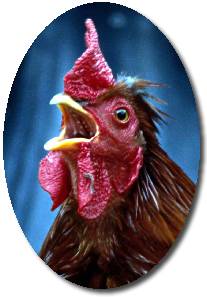

| Sonoma Has Something to Crow About |
| By Abigail Sawyer |
|
The cats of Rome, who can be found lounging at the feet of gods and emperors (statues of them, at any rate), or climbing about the ruins of the Colosseum, contribute an undeniable charm to that ancient city. San Francisco just can't compete in this arena. It does have its sea lions at Pier 39, but watery mammalian mascots lack the social appeal of those who go wandering about town. And the pigeons that so plagued Herb Caen are hardly unique to this city. But just north of here is a community known for, among other things, its feral chickens. You may have seen them in the Plaza during your last visit to Sonoma. There among the geese and ducks for whom the pond is home -- no, your eyes do not deceive you -- is a rooster, clucking and crowing to beat the band. And the Plaza isn't the only place these fowl creatures like to hang out. Sonoma is generally free of big city traffic problems, but it is not at all unusual for drivers to be held up a few moments while a chicken is allowed to cross the road. For the last couple of years, the preferred egg-laying refuge of Buffy the Hen has been Baksheesh, an international crafts shop on the north side of the Plaza. Buffy's presence often startles shoppers, but once they get over their surprise, their response is usually quite genial, according to store owner Candi Smucker. Smucker even tells of sending a young visitor home with one of Buffy's eggs for breakfast the next day. One might think the chicken population could easily get out of hand. What, after all, is the acceptable ratio of chickens to people? According to Al Bandur, public works director for the City of Sonoma, hungry hawks, which normally hunt in Sonoma's vineyards or the surrounding hills, keep the numbers well under control. Still, Bandur admits, in spite of the hawks, he and his staff have to thin the chicken flock periodically. "That means finding the birds nice homes in the country -- honest!" A misunderstanding about this earlier in the year had the town in an uproar. "It took off that there was an aim to get rid of the chickens," says Bandur, but "that was never the case." Bandur insists that the town's policy of letting nature takes its course, only occasionally intervening to relocate a few surplus fowl (he estimates the size of the Plaza flock to be about two dozen), keeps any public health concerns under control. "I never get complaints about them," he says. In fact, during the period of misunderstanding last winter, a citizen's action group formed almost immediately. The Sonoma Save the Chickens League enlisted the aid of the Sonoma Valley Visitors Bureau, which sent out press releases on behalf of the poultry. Several meetings and even a rally were held to discuss and draw attention to the chickens' fate. The crowing subsided once the public realized there was no real threat to the cluckers' continued residence in the Plaza. "It turned out great for the chickens," says Amy Breall of the Sonoma Valley Visitors Bureau. "They're still here, and they're doing really well. I think it's a real tribute to the locals who stood up for the little guys." |